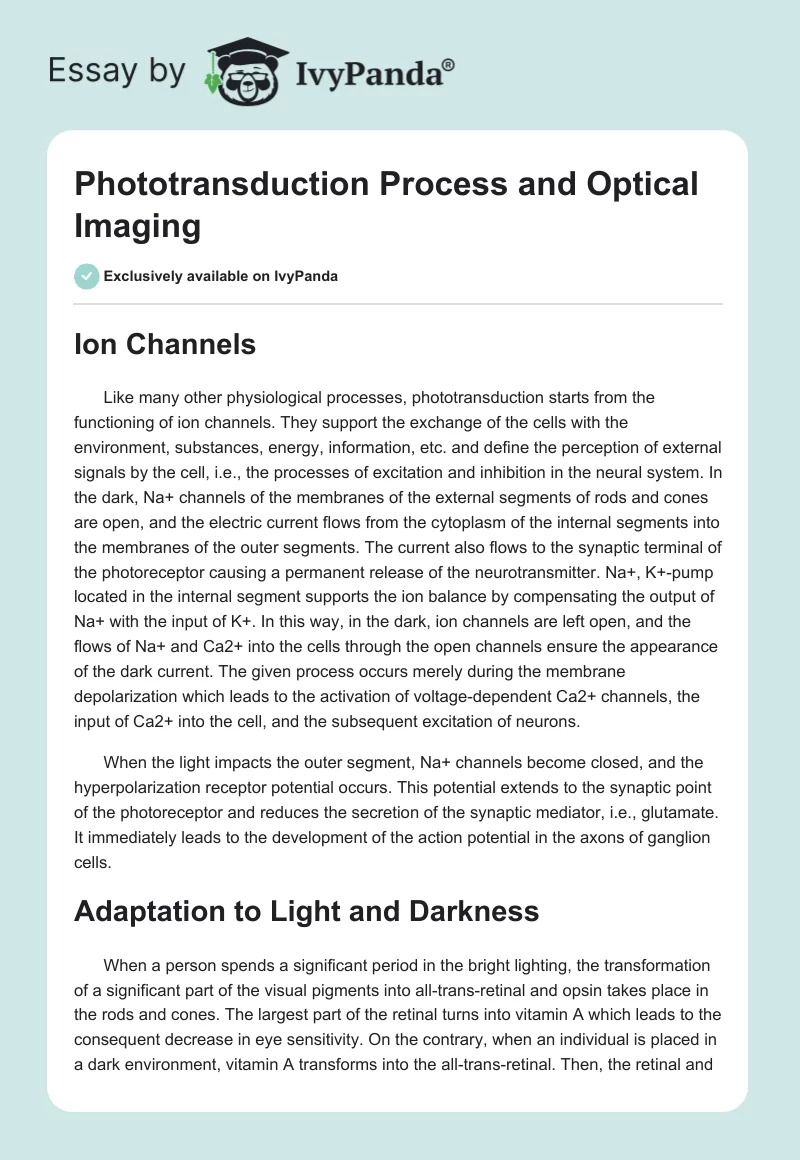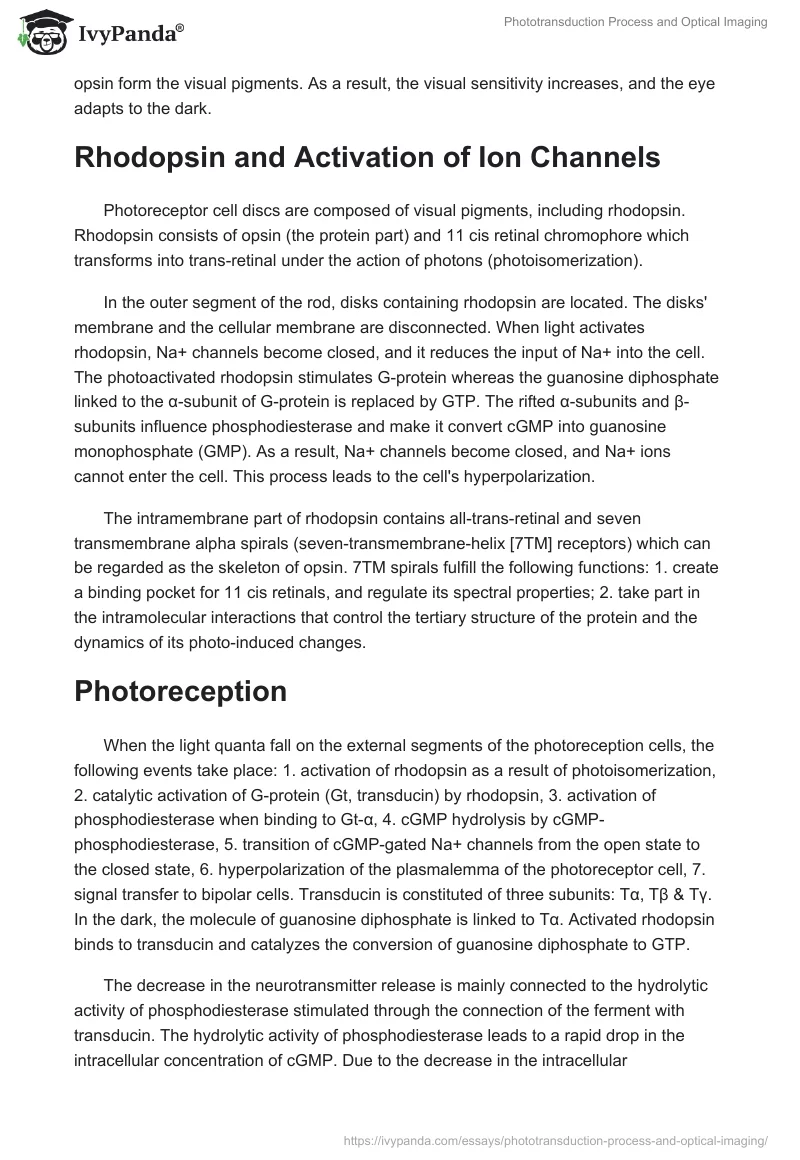Ion Channels
Like many other physiological processes, phototransduction starts from the functioning of ion channels. They support the exchange of the cells with the environment, substances, energy, information, etc. and define the perception of external signals by the cell, i.e., the processes of excitation and inhibition in the neural system. In the dark, Na+ channels of the membranes of the external segments of rods and cones are open, and the electric current flows from the cytoplasm of the internal segments into the membranes of the outer segments. The current also flows to the synaptic terminal of the photoreceptor causing a permanent release of the neurotransmitter. Na+, K+-pump located in the internal segment supports the ion balance by compensating the output of Na+ with the input of K+. In this way, in the dark, ion channels are left open, and the flows of Na+ and Ca2+ into the cells through the open channels ensure the appearance of the dark current. The given process occurs merely during the membrane depolarization which leads to the activation of voltage-dependent Ca2+ channels, the input of Ca2+ into the cell, and the subsequent excitation of neurons.
When the light impacts the outer segment, Na+ channels become closed, and the hyperpolarization receptor potential occurs. This potential extends to the synaptic point of the photoreceptor and reduces the secretion of the synaptic mediator, i.e., glutamate. It immediately leads to the development of the action potential in the axons of ganglion cells.
Adaptation to Light and Darkness
When a person spends a significant period in the bright lighting, the transformation of a significant part of the visual pigments into all-trans-retinal and opsin takes place in the rods and cones. The largest part of the retinal turns into vitamin A which leads to the consequent decrease in eye sensitivity. On the contrary, when an individual is placed in a dark environment, vitamin A transforms into the all-trans-retinal. Then, the retinal and opsin form the visual pigments. As a result, the visual sensitivity increases, and the eye adapts to the dark.
Rhodopsin and Activation of Ion Channels
Photoreceptor cell discs are composed of visual pigments, including rhodopsin. Rhodopsin consists of opsin (the protein part) and 11 cis retinal chromophore which transforms into trans-retinal under the action of photons (photoisomerization).
In the outer segment of the rod, disks containing rhodopsin are located. The disks’ membrane and the cellular membrane are disconnected. When light activates rhodopsin, Na+ channels become closed, and it reduces the input of Na+ into the cell. The photoactivated rhodopsin stimulates G-protein whereas the guanosine diphosphate linked to the α-subunit of G-protein is replaced by GTP. The rifted α-subunits and β-subunits influence phosphodiesterase and make it convert cGMP into guanosine monophosphate (GMP). As a result, Na+ channels become closed, and Na+ ions cannot enter the cell. This process leads to the cell’s hyperpolarization.
The intramembrane part of rhodopsin contains all-trans-retinal and seven transmembrane alpha spirals (seven-transmembrane-helix [7TM] receptors) which can be regarded as the skeleton of opsin. 7TM spirals fulfill the following functions: 1. create a binding pocket for 11 cis retinals, and regulate its spectral properties; 2. take part in the intramolecular interactions that control the tertiary structure of the protein and the dynamics of its photo-induced changes.
Photoreception
When the light quanta fall on the external segments of the photoreception cells, the following events take place: 1. activation of rhodopsin as a result of photoisomerization, 2. catalytic activation of G-protein (Gt, transducin) by rhodopsin, 3. activation of phosphodiesterase when binding to Gt-α, 4. cGMP hydrolysis by cGMP-phosphodiesterase, 5. transition of cGMP-gated Na+ channels from the open state to the closed state, 6. hyperpolarization of the plasmalemma of the photoreceptor cell, 7. signal transfer to bipolar cells. Transducin is constituted of three subunits: Tα, Tβ & Tγ. In the dark, the molecule of guanosine diphosphate is linked to Tα. Activated rhodopsin binds to transducin and catalyzes the conversion of guanosine diphosphate to GTP.
The decrease in the neurotransmitter release is mainly connected to the hydrolytic activity of phosphodiesterase stimulated through the connection of the ferment with transducin. The hydrolytic activity of phosphodiesterase leads to a rapid drop in the intracellular concentration of cGMP. Due to the decrease in the intracellular concentration of cGMP, the closure of cGMP-dependent cationic channels in the plasma membrane takes place.
The inactivation part of the phototransduction cascade includes the reactions leading to the restoration of membrane potential. These processes include 1. the shutdown of the active form of rhodopsin, 2. the shutdown of the active transducin/phosphodiesterase complex, and 3. the restoration of the initial cGMP concentration and the consequent opening of the specific channels.


